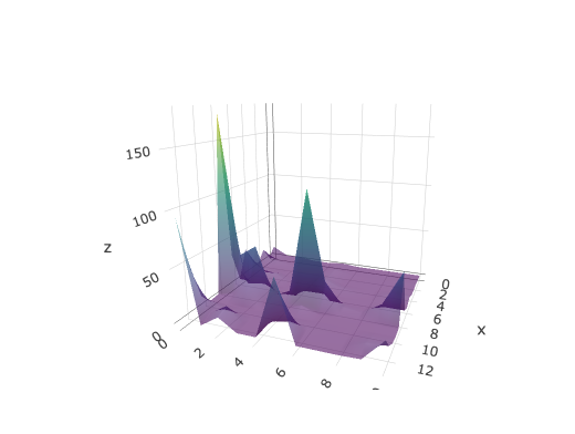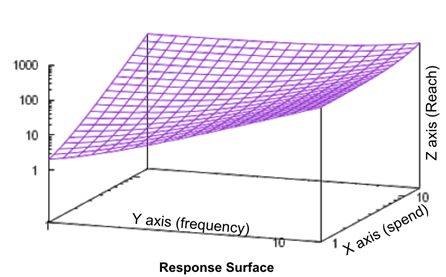Understanding Multi-Dimensional Response Curves in Marketing
How do effective marketers predict the impact of their strategies with precision?
There's a science to this craft. Beyond the realm of simple A/B testing lies the multi-dimensional response curve, a sophisticated model rooted in statistical analysis and predictive algorithms. Here, where the interplay between variables is carefully deconstructed, we discern complex consumer behaviors, thus enabling targeted strategies that resonate with nuanced market segments.
Key Takeaways Covered in this Post:
- Decoding Multi-Dimensional Response Curves
- The Limitations of Traditional Models in Marketing
- The Importance of Multi-Dimensional Response Curves in Marketing
- 3 Factors Affecting Multi-Dimensional Response Curves
- Analyzing Response Curves Data for Decision-Making
- The Future of Multi-Dimensional Response Curve in Marketing
- The Rise of Generative AI and Machine Learning

Decoding Multi-Dimensional Response Curves
A multi-dimensional response curve is a complex framework designed to model consumer interactions. This response curve considers demographics and temporal dynamics to create a detailed picture of market responses. Marketers use multiple axes to plot variables, allowing them to understand the cause-and-effect relationships within their data more comprehensively and non-linearly.
Sophisticated models, like generative attribution, help decision-makers navigate marketing's complex landscape. Once seen in isolation, variables reveal their interdependencies through multi-dimensional analysis. This allows for strategic alignments that more clearly and predictably forecast consumer engagement.
For example, marketers can identify target audience segments by analyzing the response curve for a new product launch based on variables like age, income level, and time of day. This information enables them to tailor marketing campaigns and messaging to effectively engage these segments, leading to data-driven decisions that optimize marketing strategies and maximize consumer engagement.
The Limitations of Traditional Models in Marketing
Traditional models overlook the fact that various factors influence consumer behavior. Due to historical data, technology constraints, and the simple fact that factors can differ from person to person, traditional models lack accuracy when predicting consumer response. Traditional models also neglect to consider the multi-dimensional nature of consumer behavior. They only consider the relationship between media exposure and consumer response, ignoring other influential factors like XXXX, XXXXX, and XXXX.
Ultimately, this ‘lack of accuracy’ and ‘neglection’ results in
- An incomplete understanding of consumer behavior
- Inaccurate predictions
- Ineffective marketing strategies
- Inefficient marketing spend - wasting valuable dollars
The Importance of Multi-Dimensional Response Curves in Marketing
Embracing multi-dimensional response curves is important to overcoming traditional media measurement limitations. These curves provide a better understanding of how different factors affect consumer response. By considering factors like demographics, locations, attitudes, time, and media exposures, marketers can gain a more comprehensive picture of how exposure to advertising impacts buying decisions. This produces more insightful data for effective brand campaign decision-making.
Demographic factors like age, gender, income, and education greatly affect consumer response to advertising. Household mix and cultural influences also play a role in shaping consumer behavior and response patterns. By understanding how these factors interact with media exposure, marketers can customize their campaigns for specific target audiences.
3 Factors Affecting Multi-Dimensional Response Curves
In marketing analysis, three important factors greatly influence consumer behavior and shape response curves - Education, Household Mix, and Culture. It is essential for marketers to understand these factors to accurately predict outcomes, optimize strategies, and allocate resources efficiently. Let's examine each factor in depth.
Education
The level of education an individual possesses can impact their decision-making process, comprehension of marketing messages, and perception of value. Marketers must consider the educational background of their target audience to customize their messaging and communication strategies accordingly. By understanding their audience's educational preferences and requirements, marketers can develop more relevant and impactful campaigns that resonate with consumers and generate higher response rates.
Household Mix
Family size, age, and roles influence purchasing decisions and response rates. The composition and dynamics of a household greatly impact response curves.
For example, households with children may have different priorities than older adults. Marketers must consider household mix when designing marketing strategies to target the right audience effectively. Marketers can customize their offerings by understanding the unique needs of different household compositions to maximize response rates and engage customers.

Culture
Various cultures have different values, beliefs, and norms that impact how people interpret and react to marketing messages. Marketers must be mindful of cultural nuances and adjust their strategies accordingly. By grasping the cultural context of their target market, marketers can create campaigns that deeply resonate with consumers, fostering trust and forging strong connections. Considering cultural factors when analyzing response curves enables marketers to optimize their strategies and ensure their messages effectively reach the target audience.

The chart above shows the following curves – Frequency, Spend, and Reach. The optimization chart projects onto a response surface in a multi-dimensional space. It considers market orientation, media exposure level, and consumer characteristics. This differs from a typical curve in 2D space because it captures more information. The optimization engine determines the best allocation of spending. The curves have equal slopes, and the budget is fully utilized.
Analyzing Response Curves Data for Decision-Making
Various factors influence a person's response rate in media and advertising. These curves show how consumers react to pricing, promotion, and distribution changes. By understanding these interactions, marketers can increase their accuracy of predicted outcomes, optimize tactics, and allocate resources accordingly. Interpreting curve data strategically guides brands to make optimal decisions that align with market dynamics and their consumer preferences.
The Future of Multi-Dimensional Response Curves in Marketing
Today, generative AI and machine learning provide multi-dimensional response curves, offering more profound insights into complex consumer landscapes.
- AI-driven predictive analytics is becoming more advanced as technology enables faster, more affordable processing of huge datasets. Advancements in big data processing facilitate granular analysis down to the individual media impression level.
- Marketing response curves can now change from static models to dynamic, adaptive frameworks adapting to variables in a fluid marketplace and more accurately predicting consumer actions.
- Generative attribution enables a new era of hyper-personalized marketing. These approaches adjust in near real-time to optimize and personalize marketing strategies based on predicted changes in consumer behavior.
Advancements in big data processing are leading to a paradigm shift in maximizing marketing efficiency. These advancements enable granular analysis down to the individual media impression level. This unlocks the potential for marketers to fine-tune campaigns with unparalleled precision.
The Rise of Generative AI and Machine Learning
AI significantly impacts marketing by using iterative learning and pattern recognition to predict future behaviors. Traditional linear, two-dimensional analysis, which is widely used for developing response curves, has become obsolete.
Generative AI and machine learning together transform marketing dynamics. They anticipate consumer trends to inform decision-making processes. This intelligence-driven marketing landscape empowers marketers to navigate consumer engagement confidently with minimal risk because many more influences on response are analyzed.
Generative AI and Machine Learning insights allow the creation of adaptive response curves that react to market changes instantly. Here’s how:
- Generative AI and machine learning enable a new analytical paradigm where response curves are dynamic roadmaps based on media exposure impact across different types of people.
- Machine learning algorithms analyze enormous datasets to uncover complex advertising exposure and consumer response patterns.
This capability ensures that marketing strategies remain agile and data-driven, providing a competitive advantage in the market.
Master Multi-Dimensional Response Curves with Marketing Evolution
Don't settle for outdated measurement tools and traditional approaches. Take your marketing to new heights with Marketing Evolution's Generative AI and Machine Learning-influenced attribution tools.
Request a demo to learn how we can help you know our brand’s multi-dimensional response curves.
You will achieve unparalleled success in your marketing efforts by personalizing your campaign strategy to resonate with your target audience and optimize your marketing ROI.


.png?width=514&height=132&name=KO%20CTA%20CHANGES%20(1).png)